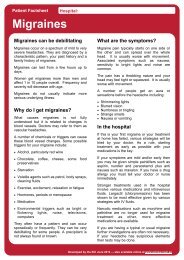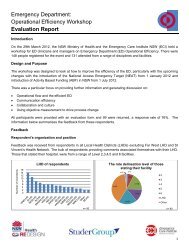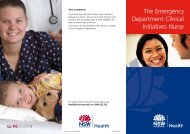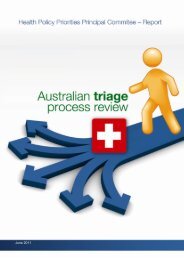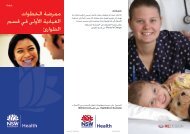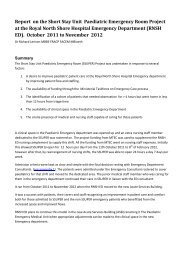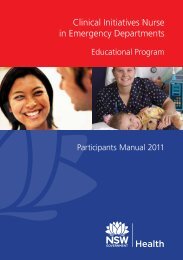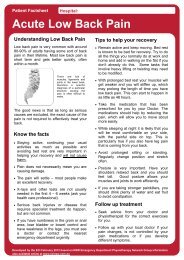Facilitators Manual - Emergency Care Institute
Facilitators Manual - Emergency Care Institute
Facilitators Manual - Emergency Care Institute
You also want an ePaper? Increase the reach of your titles
YUMPU automatically turns print PDFs into web optimized ePapers that Google loves.
FACILITATORs’ <strong>Manual</strong> Transition to <strong>Emergency</strong> Nursing5 Clinical skills assessmentsThe following are some clinical skills assessments. These will need to be undertaken with an agreedassessor who will be able to sign when you achieve mastery. This is not an exhaustive list of clinicalskills that you may learn or undertake in the <strong>Emergency</strong> setting and you and/or your facilitator mayadd more to this section.5.1 Primary Survey – Airway40AAirway Assessment Assessment Tips Yes NoLookListenFeelIs the airway patent?Look for:• Foreign bodies, obstruction or partial obstruction, brokenor dislodged teeth or dentures.• Injury – traumatic or inhalation.• Bleeding or swelling inside the mouth.• Secretions – blood, vomit, sputum, food, soot.• Soft tissue injury to face or neck, facial fractures, burns(Singed facial /nasal hairs).• Difficulty swallowing.• Angioedema (oedema in the mucosal membrane).• Drooling.Listen for:• Is there any airway noises? (stridor, gurgling or hoarsenessof voice etc.)Feel for:• Expired air.Mastery Yes NoAssessor’s Nameand Designation:Assessor’sSignature:Date:Comments:INTERVENTIONS – AIRWAYClinical SkillJaw thrustHead tilt/chin liftDate MasteryAchievedName, designation and signature of AssessorOropharyngeal airwayinsertion – guedelsNasopharyngeal airway insertionAssisting in intubation (optional –dependent of facility requirements).Suctioning techniques




